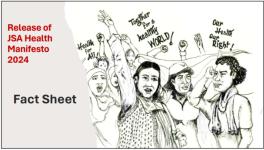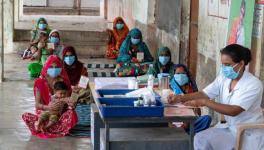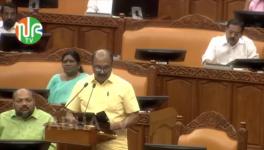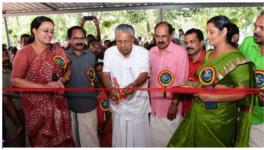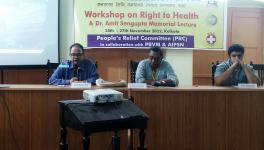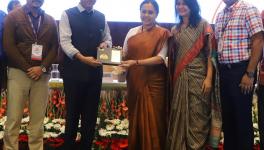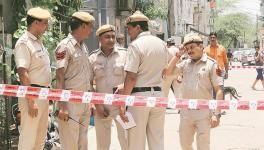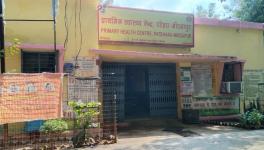UID and Public Health: Specious Claims
Among the many reasons cited for India to proceed ahead with the Unique Identification (UID) project -that it will facilitate delivery of basic services, that it will plug leakages in public expenditure and that it will speed up achievement of targets in social sector schemes - the most specious is perhaps the claim that it will help India reach her public health Millennium Development Goals (MDGs).
Despite impressive economic growth in the country, in addition to starvation deaths, the huge load of preventable and communicable diseases remains substantially unchanged. Although life expectancy has increased and infant and child mortality rates have declined, these have been relatively modest. Infant and child mortality take an unconscionable toll of the lives of 2.2 million children every year. We are yet to achieve the National Health Policy 1983 target to reduce the Infant Mortality Rate (IMR) to less than 60 per 1000 live births in all the states of the country. More serious is the fact that the rate of decline in the IMR has been decelerating, from 27 per cent in the eighties to only 10 per cent in the nineties. The same is true for the rate of decline in the mortality rate of children under five from 35 per cent in the eighties to 15 per cent in the nineties. It is clear that India will not reach the Millennium Development Goals of reducing IMR, U5MR and the MMR.
India has more maternal deaths than any other country. The NHP 1983 target for 2000 was to reduce Maternal Mortality Rate to less than 200 per 100,000 live births by 2000. However, in 2000, between 115,000 and 170,000 women died in childbirth, accounting for about one-quarter of all maternal deaths worldwide Far from declining over the 1990s, maternal and neo-natal morbidity and mortality rates in India have, at best, plateaued. High, and unconscionable as these levels of maternal mortality are, it is nevertheless critical to bear in mind that they represent just a fraction of the morbidity and mortality load borne by women in the country. Thus, for instance, deaths due to anaemia among women who are not pregnant are twice as much as among those who are. Similarly, communicable diseases take a much higher toll than that due to pregnancy and childbirth.
The reasons for this state of affairs are complex and stem above all from lack of political and financial commitment to build a public health system that can meet the challenges we face. As the National Health Policy (NHP) 2002 admitted, this is, at 0.9 per cent of the GDP the fifth lowest public expenditure on health in the world. The decline in public investments over the years was matched with growing subsidies to the private sector in health care in a variety of ways. Thus we have the largest - and one of the least regulated - private health care industry in the world. Evidence from across the country indicates that access to health care has declined sharply over the last two decades. As the government admits, the policy of levying of user fees has impacted negatively upon access to public health facilities, especially for poor and marginalised communities, and to women.
It is to be remembered that along with poor public financing, India has one of the highest private medical expenditures in the world: out- of- pocket expenditure accounts for 83 per cent of the total health expenditure in the country. It is thus not surprising that, as the NHP 2002 notes, medical expenditure has emerged as one of the leading causes of indebtedness. At the same time, the proportion of people not availing any type of medical care due to financial reasons increased between 1986-87 to 1995-96: from 10 to 21 per cent in urban areas, and from 15 to 24 per cent in rural areas. It is not just the poor, but even the middle classes - the upper echelons of whom welcomed globalisation - are finding it increasingly difficult to meet medical care costs.
These did not occur because of lack of “demand” for health care as the UID working paper on public health would have us believe as it sets out what it calls “killer application” to provide citizens an incentive to obtain a UID card in order to meet health needs. This unfortunate language apart, the fact that we have not built a health system is hardly fortuitous. It is true that we do not have good quality health data or indeed even vital statistics; it is true that this should come from integrated routine health system and not ad-hoc surveys.
However, the UID is not designed to meet the public health challenges in the country and should not pretend to do so. On the contrary, given that many diseases continue to bear a stigma in this country, the UID scheme has the unique potential of increasing stigma by breaching the anonymity of health data collected. It thus violates the heart of the medical encounter, namely confidentiality. By making this information potentially available to employers and insurance companies, the scheme bodes further gross violations of health rights.
The justification that the launch of the Rashtriya Swasthya Bima Yojana provides a “killer” opportunity for the UID scheme to free ride is equally moot; the only evaluation of the RSBY scheme, in Kerala a state with extremely good health indicators, indicates a number of problems, in particular an inability to reach marginal groups (Narayana D., “Review of Rashtriya Swasthya Bima Yojana”, Economic and Political Weekly, vol.xlv, No.29, 17th July 2010).
The biometric health insurance cards issued to Delhi slum-dwellers under the State government's “Mission Convergence” scheme requires card-holders to identify themselves with a fingerprint before they can avail of free hospital treatment. NGOs involved in the scheme say that they are inundated with complaints about malfunctioning fingerprint readers which fail to authenticate even after multiple swipes. Since the scheme is tied up with private health providers, users in need of emergency treatment often end up paying inflated fees for services that they could get at lower cost, if not free, at a government hospital.
While there are systemic problems for low health access and outreach (such as low – and falling- immunization coverage), to pretend that the UID scheme offers a solution to the problem is dissembling at best, and dishonest at worst. The UID scheme has thus little to offer for improvement in the public health situation in the country. On the other hand, the UIDAI has much to gain from a link-up with the public health system. As the UIDAI working paper on public health puts it, “The demand pull for this needs to be created de novo or fostered on existing platforms by the respective ministries. Helping various ministries visualise key applications that leverage existing government entitlement schemes such as the NREGA and PDS will get their buy-in into the project .... and will also build excitement and material support from the ministries for the UID project even as it gets off the ground.”
Given the significant potential for misuse of data, human rights violations and breach of confidentiality of health information, one hopes that the Ministry of Health will restrain its “excitement” and undertake a rigorous analysis of the costs and risks of the scheme before providing “material support” to the UID project.
Dr. Mohan Rao is a Professor at the Centre of Social Medicine and Community Health at Jawaharlal Nehru University, New Delhi
Get the latest reports & analysis with people's perspective on Protests, movements & deep analytical videos, discussions of the current affairs in your Telegram app. Subscribe to NewsClick's Telegram channel & get Real-Time updates on stories, as they get published on our website.










